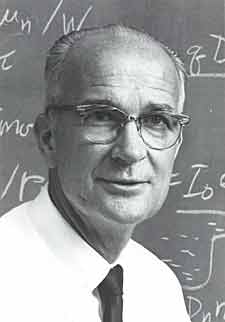William Shockley
William Shockley: Biography
<pageby comments="false" nominor="false"></pageby>;
William Bradford Shockley was born in 1910 to William and May Shockley. His father was a mining engineer and his
mother was one of the first women surveyors in the United States. During his early childhood his family moved around a great deal, and his parents educated him at home until he was eight years old. After the Shockleys settled down in California, William began to attend school. He attended college at the California Institute of Technology and then went to the Massachusetts Institute of Technology for a doctorate in physics, which he received in 1936. In 1934 he married Jean Bailey, with whom he had three children.
Shockley’s first job after graduate school was with Bell Labs. While studying fission as an energy source, he came up with the same ideas about chain reactions that scientists working on the Manhattan Project later used to develop nuclear reactors. He became a leading spokesperson for operations research, and as a member of the Anti-Submarine Warfare Operations Group during World War II contributed to saving thousands of lives. He also won the National Medal of Merit for training American bomber crews in the Army Air Corps.
Returning to Bell Labs after the war to continue solid state physics research, Shockley hired John Bardeen to work with Walter Brattain on finding a replacement for bulky and inefficient vacuum tubes. He was the administrative leader of the project but was not directly involved until after Bardeen and Brattain built a point-contact transistor in 1947. A few weeks later Shockley designed the junction transistor, which was easier to mass produce. All three scientists received credit for inventing the transistor and jointly won the Nobel Prize in Physics in 1956.
In 1953 Shockley left Bell Labs and moved to California. Within a few years he married his second wife, Emily Lanning, and started Shockley Semiconductor in northern California, an area that would become the home of the high-tech industry. He hired an extremely talented team of researchers but the company never really took off and Shockley didn’t share in the wealth of Silicon Valley. In 1957 a group of major researchers sometimes known as the “traitorous eight,” but more fairly called “the Fairchild eight,” left his company, and by 1968 the business folded. Shockley began to teach at Stanford, but his reputation as an excellent teacher was compromised by his growing interest in eugenics. Still recognized as an innovative physicist but tainted as a racist, Shockley died in 1989.
<rating comment="false"> Well Written? 1 (No) 2 3 4 5 (Yes) </rating> <rating comment="false"> Informative? 1 (No) 2 3 4 5 (Yes) </rating> <rating comment="false"> Accurate? 1 (No) 2 3 4 5 (Yes) </rating>
